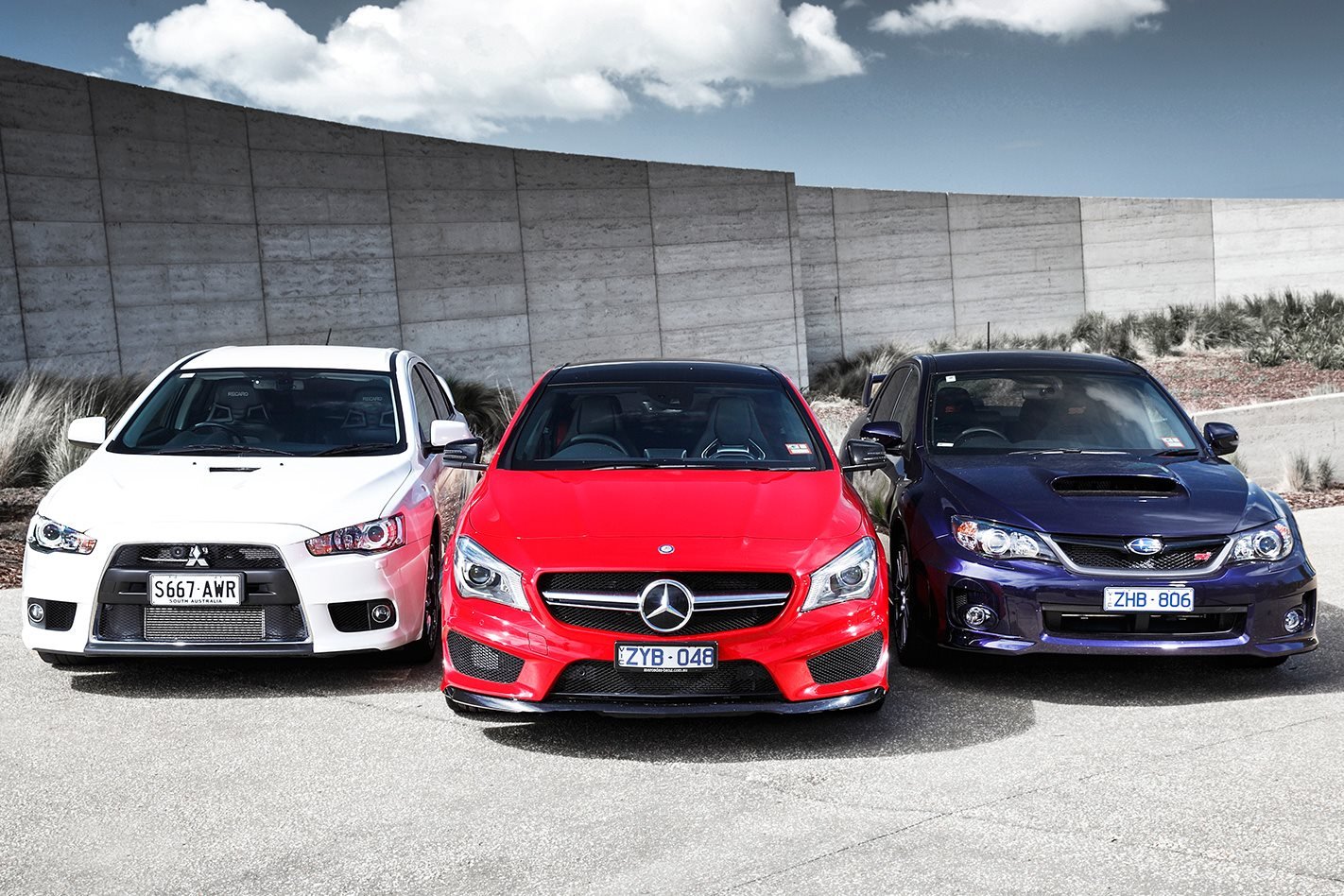Uncork Mercedes-Benz’s CLA 45 AMG and it takes 30 seconds to suspect and an hour to confirm that Germany has stolen what was, just a few years ago, exclusively Japan’s – the giant-killing, all-wheel turbo four-banger crown.
This story was originally published in our December 2013 issue
That first thirty seconds makes a big impact, time enough to climb into the sumptuous leather-dipped cabin, strap yourself into the superb pews, fire up the most potent 2.0-litre turbo four now in volume production, engage ‘S’ sport mode and punch through the first three or four ratios of the slick seven-speed twin-clutch, each upshift met with a bold, rev-matching ‘BRAP’.
But it’s not simply the off-the-line acceleration that, not long ago, only a Japanese small four- or five-door could deliver. It’s an entire cocktail of premium luxury, richness, detail, quality and Germanic precision cocooning its ballistic potental that strongly suggests the game, and its rules, have changed.

Two cars that are so often forgiven for their shortcomings in all-roundedness – despite the handsome price tags – because they trade so hard on their impressive bang factor.
The Germans were always going to create hyper all-wheel small cars. It wasn’t a case of if, but when. VW’s Golf R signalled intent, but lacks the Japanese cars’ sheer potency. Audi launched its RS3, BMW its (turbo-six-powered) M135 x-drive, but neither made it to Oz. The CLA 45 AMG, and mechanical twin A45 five-door hatchback, are Australia’s fresh taste of where the game has moved to.

That is until 2008 arrived. Neither of the current Evo and STI breeds have changed or been improved measurably in six years, a strong signal that Mitsubishi and Subaru have dropped the ball by sitting on their hands and resting on their laurels.
Blame the abandonment on the GFC or spiralling pressures with tougher fuel economy and emission targets but, frankly, the Germans are in the same evolutionary boat, and the Deutsch car makers could well have hoisted the standards for small rocket ship excellence beyond Japan’s reach.
Or have they? Sure, fanboys and fangirls might be irked that prices for the ageing rally-bred Evo and STI haven’t dropped much since 2008. A self-shifting, six-speed twin-clutch Evo wants for $61,990, our bells and whistles MR version asking for an extra $4K.
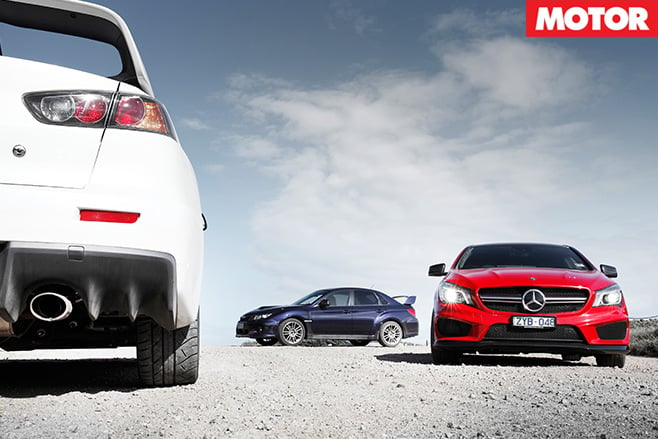
But while the Japanese cars haven’t become more savage in the current generation, they’re certainly no less potent than ever. And the CLA 45 AMG asks for a hefty premium, at $86,900. At a whole third of price more than Japan’s entry point, yes, it had want to be much nicer. And, perhaps, much quicker, too. But is it? We’re here to find out.
The Evo inline 2.0-litre offers 217kW at 6500rpm and 366Nm at 3500rpm, while the STI’s larger-bore, shorter-stroke 2.5-litre flat four makes 221kW lower, at 6000rpm, but its superior 407Nm higher in the rev range, at 4000rpm. The AMG favours a long-stroke design of just two litres, yet creates benchmarking outputs of 265kW at 6000rpm and a humongous 450Nm from just 2250rpm upwards.
More telling is power-to-weight. The twin-clutch Evo sedan tips the scales at 1625kg, thus offering 133.5kW per tonne. Meanwhile, the conventional manual STI sedan saves 110kg of kerb weight, its higher power figure conspiring to a healthier 145.8kW per tonne.
At 1510kg, the AMG undercuts the Japanese cars on the weigh bridge, and thanks to an astonishing specific output it makes for a monstrous 175kW per tonne.
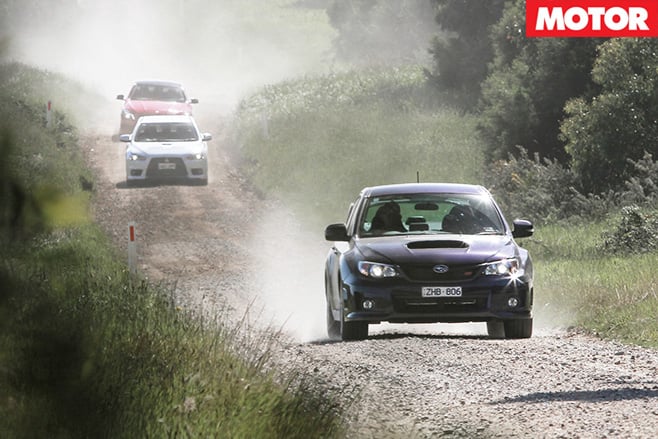
The Evo feels shorter geared, too, allowing the 2.0-litre to find and maintain the sweet spot band between peak torque and power more easily.
There’s certainly difference in engine character too. The Evo has little lag, excellent response and strident low-to-mid-range shove, but it feels to run out of top end. The Subaru’s boxer is most explosive between 4000rpm and cut-out, yet lacks the linearity and throttle control of the Mitsubishi.
The AMG absolutely scorches to the 100km/h mark in just 4.6 seconds – a full second quicker than the Japanese cars. Some of the benefit comes from its launch control. Some of it the superior torque clocking in a more accessible low-rpm point. But you sense that all of the electronic and mechanical engineering charged with acceleration is operating in unison with absolute, finely tuned precision.
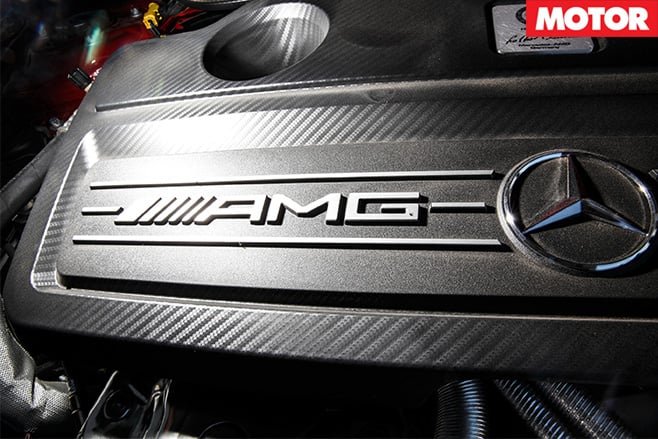
While we’re at, yes, there is self-shifting STI, but the transmission is a slush-box auto of only five speeds, the engine is detuned to 350Nm and, crucially, the spec omits much of the rally-bred drivetrain trickery – most notably the motorsport-grade differentials front, middle and rear – to qualify it as a ‘real’ STI in any traditional and technical sense. As mentioned, it’s STI-lite.
After all, an Evo’s or STI’s rally-bred drivetrain – the tricky diffs and torque shuffling smarts that make up the former’s Super All Wheel Control and the latter’s Driver Control Centre Differential systems – not only imbue heroic on-limit dynamics. It’s their soul. It’s the main reason why you stump up for the premium over just a Ralliart- or WRX-spec stable mate.
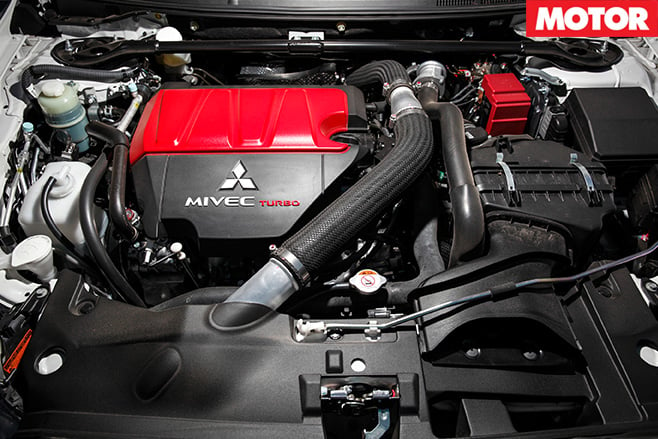
Merc-Benz will claim that off-road plays no part in the CLA 45 AMG equation. Fine. But as we discovered, the four-door coupe’s 4Matic all-wheel drive is more than a hand companion should broken surfaces arise. That said, it’s a natural understeerer with a front-drive bias.
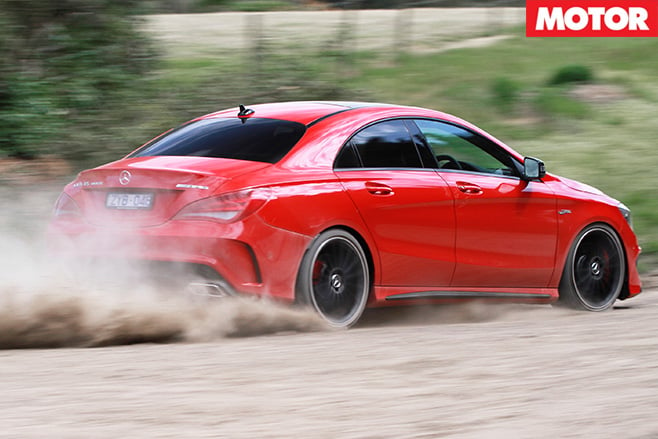
The STI is more interactive to the driver and responsive to throttle input, its Driver Control Center Differential system allows manual front-rear torque bias adjustment or automatic distribution of your choice.
The thing is, the STI isn’t terribly agile on corner entry, a bit prone to understeer, and only really comes alive once a fair whack of torque is fired through to the front axle under moderate to heavy throttle application, at which point it lunges wherever the front wheels are pointed.
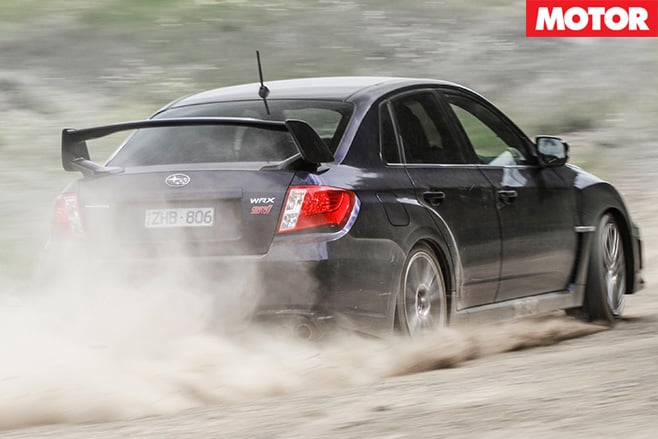
The Evo is more balanced, has more front-end bite, has less abrupt torque shuffling going on underneath and is, thus, more fun and satisfying to hustle across gravel or dirt. The Super All-Wheel Control package is a complex and clever system, but the positive upshot is that regardless of whether you set the Active Centre Differential to Tarmac, Gravel or Snow modes, the Evo remains incredibly controllable, adjustable and sure-footed.
Of the three, it offers the highest levels of directness and poise from the instant you initiate a slide. Out of the showroom box, few other road cars can touch Mitsubishi’s hero car for off-road, WRC-wannabe fun factor.
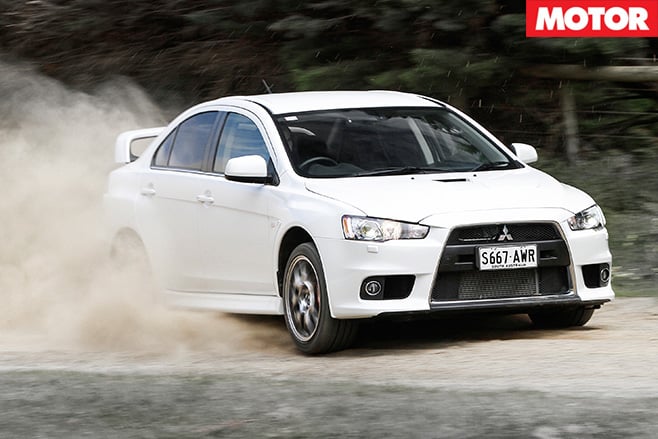
The CLA’s steering is beautiful – it’s noticeably lighter in weight than either Japanese car, and not particularly short-ratioed in its rack, yet the clarity through the wheel and linearity lock-to-lock is excellent. The Evo, while not quite the pure, mechanical communicator many of its forebears are, still faithfully connects the driver to the road with satisfying, rippling detail. The STI, however, suffers slightly from dullness and numbness through the wheel. And despite both Japanese cars running identical 245mm-wide 18-inch Dunlop rubber, the Subaru feels a bit more ponderous in its front end, with a little more reluctance to turn in to the corner.
In the mid-corner, the STI grips up beautifully, but it doesn’t sit as flat as its rivals and, despite the favourable weight advantage, feels like the heaviest and slowest to react to driver inputs.
It’s just not as keen and playful as you hoped, requiring a decent manhandling to adjust its line. Get aggressive with the throttle and it pitches torque, and weight, fore and aft with gusto, but there’s not a lot of subtlety. Rapid progress, then, is less about dynamic dexterity and driver interaction, and more about leveraging all that grip and horsepower. In that sense alone, it’s perhaps the least satisfying of the three to punt hard.

It’s surefooted and satisfying, and incredibly quick. But, almost surprisingly, not quick enough to dust the Evo on a long stretch of twisty, challenging back country roads.
Yep, that surprised us, too. But where the AMG, with its narrower 235mm 19s, finds its cornering limits and has nowhere to go, the grippier and slightly more agile Evo compensates for its lack of power and excess weight with dynamic talent and an all-wheel-drive system paying real, tangible dividends.
It’s just a little more agile and adjustable, dancing around on its tyres more, for sure, but adjusting its line more eagerly and diving into and out of corners more flamboyantly than the AMG can. Both brilliant, both very different from one another to drive, yet, ultimately, while the AMG is fast, on a twisty country road, the Evo keeps up. They’re dead even for pace.

The Japanese pair, though, portray their lower-rent roots and increasingly older-hat relevance all too conspicuously – their leathers feel plasticky, their plastics feel cheap and there’s not much in the way of celebration or premium ambience. That said, again the Evo trumps the STI, notably in sat-nav design, ergonomics and a richer air, such as the better judged use of metallic trim finishes.
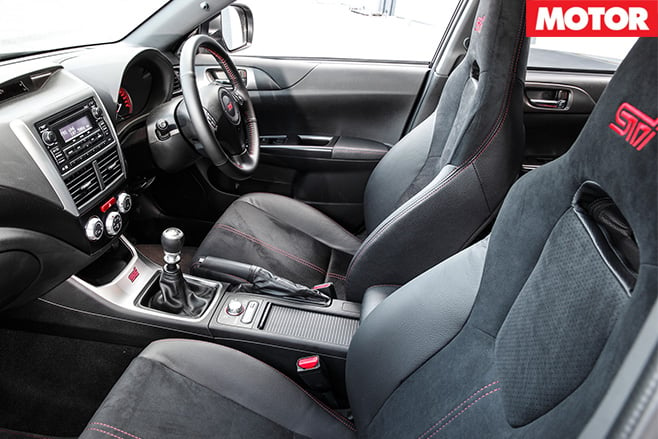
Other AMG quibbles? Although the twin-clutch transmission will hold ratios on upshifts – bouncing the engine off its rev-limiter if you feel so inclined – it’s not absolutely obedient when it comes to downshifts. And, like so many German cars today, the default shift program is a touch too lazy and its Sport mode a little too aggressive for everyday use.
An all-round superior tool? A proper giant-killing all-wheel turbo-four banger? A game-changer and new benchmark for all to aim at? Yes, yes and yes. That is discounting the CLA’s five-door twin-under-the-skin, A 45 AMG, which is just as quick, adds a touch more visceral intent in the curves, and wants for $12K less.
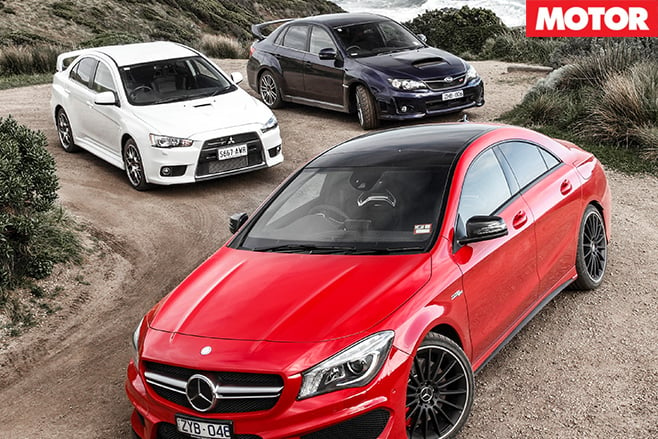
| u00a0 | u00a0 | u00a0 | Mercedes-BENZ CLA 45 AMG | u00a0 | u00a0 | SUBARU WRX STIu00a0 | u00a0 | u00a0 | Mitsubishi Lancer EVOLUTION X MR |
| Body | u00a0 | u00a0 | 4-door, 5-seat sedanu00a0 | u00a0 | u00a0 | 4-door, 5-seat sedan | u00a0 | u00a0 | 4-door, 5-seat sedan |
| Drive | u00a0 | u00a0 | all-wheel | u00a0 | u00a0 | all-wheel | u00a0 | u00a0 | all-wheel |
| Engine | u00a0 | u00a0 | 1991cc inline-4, DOHC, 24v | u00a0 | u00a0 | 2457cc flat-4, DOHC, 24v | u00a0 | u00a0 | 1998cc inline-4, DOHC, 24v |
| Bore/Stroke | u00a0 | u00a0 | 83.0 x 92.0mm | u00a0 | u00a0 | 89.0 x 72.5mmu00a0 | u00a0 | u00a0 | 86.0 x 86.0mm |
| Compression | u00a0 | u00a0 | 8.6:1 | u00a0 | u00a0 | 8.2:1 | u00a0 | u00a0 | 9.0:1 |
| Power | u00a0 | u00a0 | 265kW @ 6000rpm | u00a0 | u00a0 | 221kW @ 6000rpm | u00a0 | u00a0 | 217kW @ 6500rpm |
| Torque | u00a0 | u00a0 | 450Nm @ 2250-5000rpm | u00a0 | u00a0 | 407Nm @ 4000rpm | u00a0 | u00a0 | 366Nm @ 3500rpm |
| Power-to-weight | u00a0 | u00a0 | 175kW/tonne | u00a0 | u00a0 | 146kW/tonne | u00a0 | u00a0 | 133kW/tonneu00a0 |
| 0-100km/h | u00a0 | u00a0 | 4.6sec (claimed) | u00a0 | u00a0 | 4.9sec (claimed) | u00a0 | u00a0 | 5.3sec (previously tested) |
| Top Speed | u00a0 | u00a0 | 250km/h (claimed) | u00a0 | u00a0 | 255km/h (claimed)u00a0 | u00a0 | u00a0 | 242km/h (claimed)u00a0 |
| Fuel consumption | u00a0 | u00a0 | 6.9L/100km (claimed) | u00a0 | u00a0 | 10.5L/100km (claimed) | u00a0 | u00a0 | 10.1L/100km (claimed) |
| Emissions | u00a0 | u00a0 | 161g/km CO2 (claimed) | u00a0 | u00a0 | 243g/km CO2 (claimed)u00a0 | u00a0 | u00a0 | 256g/km CO2 (claimed) |
| Transmission | u00a0 | u00a0 | 7-speed dual-clutchu00a0 | u00a0 | u00a0 | 6-speed manual | u00a0 | u00a0 | 6-speed dual-clutchu00a0 |
| Kerb Weight | u00a0 | u00a0 | 1510kg | u00a0 | u00a0 | 1515kg | u00a0 | u00a0 | 1625kgu00a0 |
| Suspension | u00a0 | u00a0 | struts, A-arms, coil springs, anti-roll bar (f); multi links, coil springs, anti-roll bar (r) | u00a0 | u00a0 | struts, coil springs, anti-roll bar (f); A-arms, coil springs, anti-roll bar(r) | u00a0 | u00a0 | struts, coil-springs, anti-roll bars (f); multi links, coil springs, anti-roll bars (r)u00a0 |
| L/W/H | u00a0 | u00a0 | 4691/1777/1416mm | u00a0 | u00a0 | 4580/1795/1470mmu00a0 | u00a0 | u00a0 | 4510/1810/1480mmu00a0 |
| Wheelbase | u00a0 | u00a0 | 2699mm | u00a0 | u00a0 | 2625mm | u00a0 | u00a0 | 2650mmu00a0 |
| Tracks | u00a0 | u00a0 | (f/r) 1553/1552mmu00a0 | u00a0 | u00a0 | (f/r) 1530/1540mm | u00a0 | u00a0 | (f/r) 1545/1545mmu00a0 |
| Steering | u00a0 | u00a0 | electric rack-and-pinion | u00a0 | u00a0 | u00a0power rack-and-pinion | u00a0 | u00a0 | power rack-and-pinionu00a0 |
| Brakes | u00a0 | u00a0 | 350mm ventilated/drilled/slotted discs, four-piston calipers (f); 330mm ventilated/drilled discs, single-calipers (r) | u00a0 | u00a0 | 326mm ventilated discs, four-piston calipers (f); 316mm ventilated discs, two-piston calipers (r) | u00a0 | u00a0 | 350mm two-piece ventilated discs, four-piston calipers (f); 330mm ventilated discs, two-piston calipers (r) |
| Wheels | u00a0 | u00a0 | 18 x 8.0-inch (f/r), alloy | u00a0 | u00a0 | 18 x 8.5-inch (f/r), alloy | u00a0 | u00a0 | 18 x 8.5-inch (f/r), alloyu00a0 |
| Tyres | u00a0 | u00a0 | Dunlop SP 235/35 ZR18 95XL (f/r) | u00a0 | u00a0 | Dunlop SportMaxx 600 245/40 R18 93W (f/r) | u00a0 | u00a0 | Dunlop SportMaxx 600 245/40 R18 93Y (f/r)u00a0 |
| Price | u00a0 | u00a0 | $86,990 | u00a0 | u00a0 | $59,990u00a0 | u00a0 | u00a0 | $65,990 |
| Positives | u00a0 | u00a0 | Game-changing blend of dynamics, pace and luxury, bad-ass exhaust note | u00a0 | u00a0 | Engineu2019s top-end whack, rumbling exhaust note, point-and-shoot ability | u00a0 | u00a0 | Fool-proof handling, responsive engine, dynamic weapon of destruction |
| Negatives | u00a0 | u00a0 | Canu2019t shake the Evo, disobedient transmission, A 45 AMG is better value | u00a0 | u00a0 | Doughy front-end, blunt tool in this company; MY15 STI u2019round the corner | u00a0 | u00a0 | Engine sounds industrial, still looks like a u2018Lanceru2019, sheu2019s getting heavy |
| u00a0 | u00a0 | u00a0 | 4.5/5 | u00a0 | u00a0 | 3.5/5 | u00a0 | u00a0 | 4/5 |


